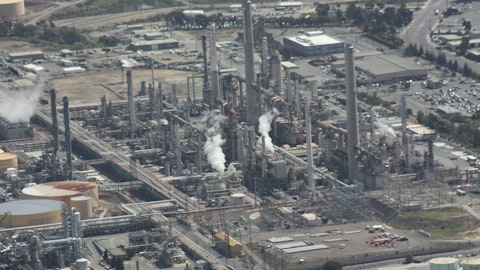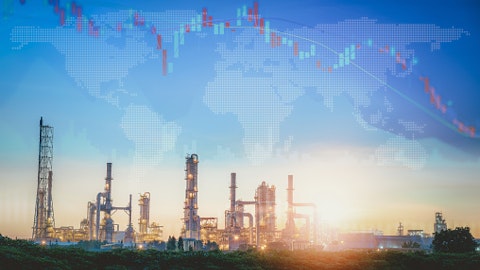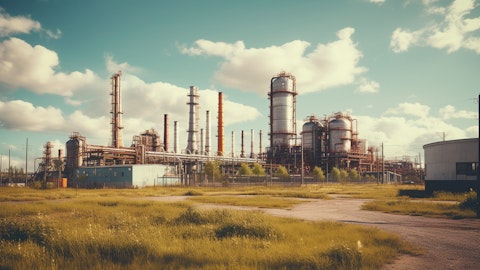Kurt Bitting: Sure. So Virgin as again, when you look at our portfolio on Virgin acid, 90% of it is really under long-term agreements, which we are adjusting on longer term contracts, right? So it’s just that that’s on that short dated or we call spot — spot sales, those sorts of things. So what we see in this area is, again, some cautious customers on the industrial side. And there’s also been some rationalization really in the pulp and paper industry. we don’t move a lot of volume into that industry, but it has created, I guess, some pockets of oversupply in different geographies where we don’t operate. But that’s created some, I’d say, temporary imbalances in a couple of the geographies that really had to settle itself out. So if I had — if we had to quantify that really, Aleksey, you talk about 10% of our virgin acid portfolio is probably $5 million to $10 million in terms of pricing that’s subject to this pressure that we’re seeing in the industrial space.
Aleksey Yefremov: Thanks, Kurt. Very helpful. You mentioned accelerated increased costs driven by investments in these emerging applications kind of hard from outside to judge us is because it just cost more to do what you envisioned? Or is it really that there’s bigger opportunity and those opportunities are coming faster, if you could elaborate on this?
Kurt Bitting: Yes. So if you — as we stated during our Investor Day, growing our emerging technologies is really a key priority for us. When we look at some of the things like advanced plastics recycling, sustainable fuels, the advancements now that we’re making on the mobilized enzymes. So we are really on the front end of that, where we’re building out our capabilities in those areas, building out our sales and marketing capabilities in these areas. So we’re making those front-end investments as expected to deliver long-term sales as we outlined in our Investor Day.
Aleksey Yefremov: Thanks a lot.
Operator: Thank you. We go next now to John McNulty at BMO.
John McNulty: Yes, good morning. Thanks for taking my questions. So question on EBITDA and advanced materials and catalysts. So it looks like the first half is going to — there were — the first quarter is going to be almost half of what it was the prior year, which kind of implies the back half or the remaining three quarters, basically flattish. So I guess, can you help us to think about where the improvement comes from is the bulk of it, just the lumpiness in HPC catalyst side or is it the polyethylene ramp that you’re talking about. I guess what’s the bigger contributor to kind of the weakness in 1Q and the snap [indiscernible] as we look under the under the remaining three quarters.
Michael Feehan: John, this is Mike. Thanks for the question. Yes, it’s a combination of all those factors, right? So we mentioned earlier that we are seeing a little bit of a cautious feel in Q1 around polyethylene starting out, but we do expect polyethylene demand to continue and actually improve over the prior year, call it, in a double-digit basis. We also see that hydrocracking, while we came off a peak year from last year, it is a little lighter in Q1 than originally anticipated, but we do see it growing in Q2, Q3 and then into Q4. So it’s a little bit of the nature of the business, primarily around the hydrocracking and the timing along with some of the niche custom catalysts. Polyethylene is more constant. However, just given off of what we saw in 2023, it’s a little lighter starting out, but it’s ramping up certainly in the later half of the year.
John McNulty: Got it. Okay. No, that makes sense. And then in one of the slides, you highlighted some weakness in the heavy duty truck market with which I assume is tied to some of the — the new regulations where there was maybe a little bit of pull forward, I guess, how long does that normally last? Is that a year? Does it tend to last a little bit longer than that? I guess how should we be thinking about that?
Kurt Bitting: Yes, thanks, John. There’s a couple of headwinds there really in the trucking where there’s just a general, I’d say, slowdown in that transportation segment right now, which is, I think, linked to the general economic uncertainty going on. So — and then they’re also coming off — working off a pretty big backlog that had developed in ’21, ’22 and ’23, where a lot of trucks were — there was big back orders and they’ve worked those off. So you see some slowness there. Additionally, the Euro VII regulation that was due to go in effect in 2027, Europeans have delayed that for 2 years, which has pushed off some of the I’d say, next-generation catalyst technologies that we’re going to go into those trucks that we’re going to reduce emissions by 80%. So the combination of those things has kind of created a little bit of a headwind for that segment this year.
John McNulty: Got it. Thanks very much for the color.
Operator: Thank you. We go next now to David Begleiter at Deutsche Bank.
David Begleiter: Thank you. Good morning. Kurt, in Ecoservices, you had a number of headwinds in 2023, the winter storm, outages, turnarounds and some weak demand and destocking. So given that, why isn’t the EBITDA growth a little faster than mid 5% plus in ’24?
Kurt Bitting: Yes, sure. Thanks for the question, David. So as we stated on the call and a few times, it’s we’ve taken a cautious look for 2024. Many of our customers, particularly in that — I’d say that industrial segment have adopted cautious approaches for 2024, and that’s played into our overall opinion on the demand trends as — especially as it relates to virgin sulfuric acid. But when you look at the — what we expect from 2024 in Ecoservices refining margins, the refining business remains healthy. We expect a strong year for regeneration. The treatment services business and Chem32 both look to have very full schedules this year. It’s the virgin acid business where we do plan on moving more volume into the market this year particularly into nylon, where there was headwinds last year, we see a recovery there.
I wouldn’t say it’s necessarily an up cycle year. However, we do expect to move more product into that nylon segment, where we see that some of the headwinds on Ecoservices is that earlier on one of the questions I talked about that industrial space and the pricing pressure is creating in that short-term and spot pricing segment of the virgin acid space as well as we’re spending about $10 million to $15 million more on maintenance and reliability this year. During the Investor Day, we talked about we have a long-term reliability enhancement program that we’re instituting, which is a combination of really additional resources at the plants as well as some automation, which is there really to deliver higher reliability as well as debottlenecking at the plants over time.
So that’s — some of the change you see there is really pushing in that extra cost to kick off that reliability enhancement program.
David Begleiter: And Kurt, on that program, is that a one-time effort or should we — i.e., in ’25 should that come back down by $10 million to $15 million? Or should that be sustained at this higher level?
Kurt Bitting: Yes. Some of that will be, and I didn’t mention too, we do have additional turnaround costs. So that will — some of that will be sustained because it’s going to be — the resources we’re putting in place will be on a sustained basis. We do have accelerated turnaround costs this year, which it’s — those mostly are actually going to take place in the first half of the year. And then the automation piece that we’re putting in place, obviously, will go on to the plan. So I would think a portion of that will be sustained over the horizon.
David Begleiter: Thank you.
Operator: Thank you. We go next now to Hamed Khorsand at BWS Financial.
Hamed Khorsand: Hi, good morning. So first question I had was given what has happened in ’23 to your business, how have you adjust in ’24? I mean are you through all the inventory that you might have had in ’23 because of disruptions and so forth. So what kind of lingering effects are there in ’24 from those effects in ’23?
Kurt Bitting: Yes, good morning, Hamed. I think really what — in terms of 2023, we obviously had $20 million-ish of headwinds that were operational related in the Ecoservices business when you go back to the winter storm that started out at the beginning of 2023, and then we had the extended maintenance downtime at the Houston plant. So we don’t expect those events this year. Obviously, I just talked about the enhanced reliability program, which we will yield higher volumes. And we do expect to produce and sell more virgin sulfuric acid volumes this year, even though I’ve talked about some of the industrial headwinds in some of the pockets in the virgin asset market. I think the other areas that we talked about last year that were headwinds for us was polyethylene catalysts, which in the second half of the year, there was destocking that went on.
We see that abating and recovering, and as Mike said, particularly in the second half. So we do expect polyethylene catalysts to be up in double digits this year. And then secondly, the Nylon segment, which impacted the virgin acid business last year in the second half, we saw destocking in that area. We do expect nylon volume to be up for us this year, albeit not certainly a high cycle year, but certainly a recovery there.
Michael Feehan: Okay. And my last question is on the slides provide today, you’re highlighting the slow conditions for heavy-duty vehicles. That’s a new item for you on the slide. Why is that such a big deal now versus prior quarters where that was not even an issue or even from a positive side or negative side? I mean, how bad of a drag is this that you’re highlighting in now?
Kurt Bitting: Yes, I think, Hamed, it’s not — I think in the past, over the past year or two, the business was largely just moving along in terms of the backlog of the heavy-duty diesel vehicles. It’s not an overly huge segment for us. And essentially, we view that market as we see headwinds there in terms of just the demand for our overall heavy-duty diesel vehicles as well as the regulation thing that I mentioned earlier on Euro 7. But when we look at it from a sales standpoint, it’s flattish for us. So I wouldn’t call it necessarily a huge drag for us. It’s just it’s an area that we see in the segment that there definitely are headwinds in that segment.
Michael Feehan: Okay. Thank you.
Operator: [Operator Instructions] We’ll go next now to David Silver at CL King.
David Silver: Yes, hi. Thank you very much. I had a question maybe about some of your spending initiatives over the next year. But for starters, there is something of an increase on — in your CapEx spend. And I’m guessing some part of that is Kansas City, and along those lines, just with the time line there. I was just — I was wondering — or I was wondering if the spend might — the CapEx spend might have even been a little bigger to prepare for the anticipated demand growth. And then beyond that, I’m just wondering if you could articulate or highlight any increase in either R&D spend or pre-commercialization type of spending. But beyond the beyond, I guess, the operational things. I mean what other kind of spending initiatives should we be thinking about to support your growth, which you highlighted in the release and in some of your comments here. But is there a way to kind of get a bigger — a clearer view of that, please.
Michael Feehan: Yes, hi, David. Good morning. This is Mike. So on the first part of the question around capital spending, you are correct. We do see about — given our guidance range at the midpoint roughly $10 million increase in CapEx spending. The predominance of that is associated with the Kansas City expansion. And I think we mentioned this during our Investor Day that would take a period of time over — certainly over at least 2-year period going into 2025. So our spend on that facility is not a bottoms-up approach. We already have structures and availability there. We’re just expanding upon that. So the CapEx cost is not perhaps as significant as you might think, with building a brand new plant, but we are adding about 50% capacity for making their polyethylene catalyst there.
We also have some additional costs in the capital spending around Ecoservices to continue to start to look and expand our Chem32 Catalyst activation business. So there’s some spending in there as well. When you look at the R&D and free commercial, Kurt mentioned earlier that we are seeing some additional spending in the — just as we start to ramp up some of our emerging products. So we are seeing a little bit of additional cost there. But again, as we mentioned, we’re very excited on where our sales have been taking us. We’ve already had some sales in 2023 related to the biocatalysis and a lot of it is exactly how we articulated during our November Investor Day. And hopefully, we also talked a little bit more about the spending on Ecoservices related to the reliability and turnaround costs that we talked about earlier.
So hopefully, that covers some of your cost — your questions on the cost and spending.
David Silver: Yes. Thank you for that. And then maybe just from another angle. Yes, I was wondering about the operational plans, the downtime overall planned by your portfolio of refining customers. So I guess refining margins largely have been very healthy for the last few years. And anecdotally, I guess, a lot of refineries have deferred or delayed downtime as much as they could to take advantage of what they viewed as favorable profit opportunities. As you kind of look at the planned downtime and planned operating strategies that you’re refiner customers have shared with you. I mean should we expect another year of very high or close to full utilization there? Or are there some major outages or downtime planned relative to maybe 2023 or 2022, excluding the weather events? Thanks.
Kurt Bitting: Sure. Thanks, David. So in terms of when we look at [indiscernible] refinery downtime, it affects two parts of the business differently. When you look at Ecoservices, on the acid regeneration we don’t really see a particularly high amount of customer turnarounds this year in their calculation units. So we’re expecting, I would say, more of an average year you look at hydrocracking catalysts, obviously, coming off a peak cycle year in 2023, selling hydrocracking catalysts, which some of those turnarounds took place in Q4 of 2023. Some of them are taking place in Q1 2024, they were buying the catalyst to have it on site for their turnaround. So we expect, and again, hydrocracking to be more of a low cycle this year, so we do expect less turnarounds in that space as well.
But those are for our customers. So there certainly are other refiners or other regions that could have different issues. But in general, I think we see certainly average in the eco-service side and less turnarounds in hydrocracking just because it’s an off-cycle year.
David Silver: Yes. Yes, you did highlight that there. Okay. That’s great. Thank you very much.
Operator: And we’ll take a follow-up question now from John McNulty at BMO.
John McNulty: Yes, thanks for taking my follow-up. So on the polyethylene catalyst demand, which is a pretty strong forecast for the year, up double digits, I guess can you help us to think about how much of that’s just core industry growth versus account wins because I think you have had a bunch of wins and some assets are still in the process of ramping up. So that may be some of the benefit. But can you help us to think about that high level?
Kurt Bitting: Sure. I mean I think it’s a mix, really, John, of both wins and just increased utilization rates. So you see a recovery, particularly I would Middle East and North America right now at very low natural gas prices are enjoying a huge arbitrage window in polyethylene production. So we obviously have a little heavier weighting to those areas. So we’re seeing some recovery in that area. And again, I think Mike mentioned we are — it’s more a more second half weighted. So a lot of it’s recovery, but yes, some — and in some of its recovery of new account wins that we’ve had as well. So it’s a little bit of a mixed bag. But if I had to give it the weighting us, I’d say it’s more just on the general recovery side.
John McNulty: Got it. Thanks for the color
Q – John McNulty: And ladies and gentlemen, it appears we have no further questions today. So that will bring us to the conclusion of Ecovyst’s fourth quarter 2023 Earnings Conference Call. We’d like to thank you all so much for joining us today and wish you all a great remainder of your day. Goodbye.




